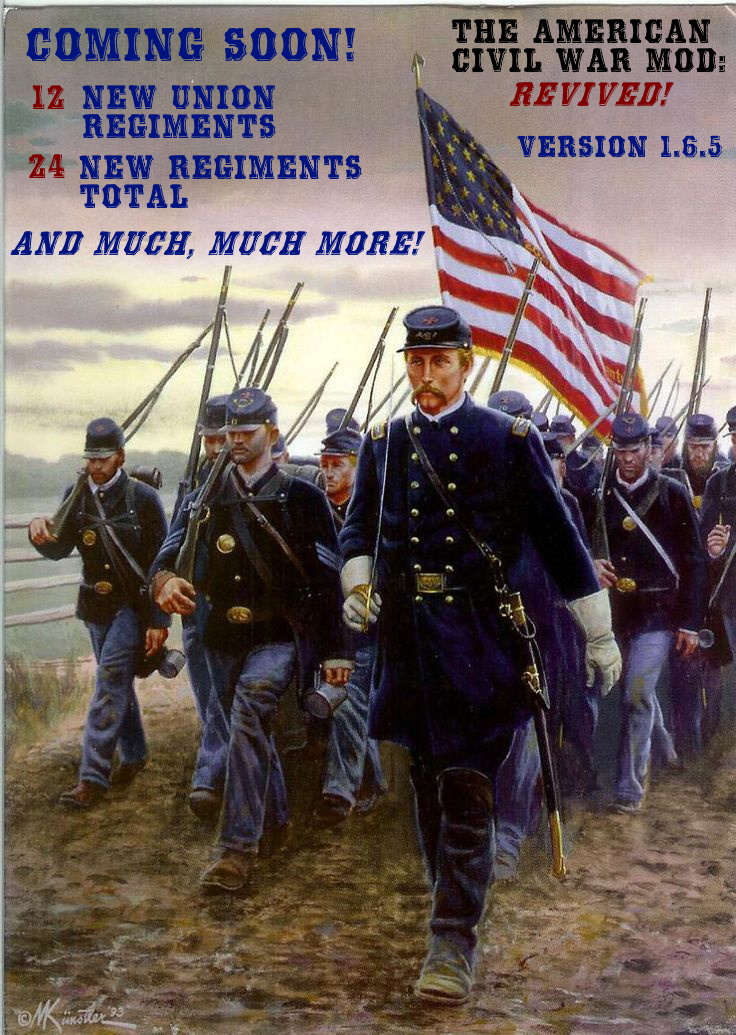
Hello everyone!
We have made quite a bit of progress since our last release, and we would like to show you some of what we have been working on. In this article, we will be showing images of some of the new Union regiments that have been added to the mod and providing a historical account of their service in the war. We will also talk about how they are armed in the mod, some details about their uniforms that are worth mentioning, what are their best roles on the battlefield, and where they will be found in the troop tree. There are a total of 24 new regiments that will be coming to the mod with the next release - 12 for both the Union and the Confederacy - so this will provide a glimpse at half of the new Union regiments, and another news article to follow this will cover half of the Confederate regiments. We will also cover a few other small but noticeable improvements. We are saving the reveal of the last 12 regiments for the mod's release, which we hope will be sometime around middle to late September, or early October.
45th New York Volunteer Infantry "5th German Rifles"
The 45th New York Volunteer Infantry Regiment, also known as the 5th German Rifles, served with the Union army almost the entirety of the war and saw action in several noteworthy battles, in both the Eastern and Western Theaters. The regiment was composed almost entirely of German immigrants and was organized in New York City by Colonel George von Amsberg, a veteran Austrian cavalry officer and revolutionary in the Hungarian revolution of 1848.
On December 2nd, 1861, while stationed in winter quarters at Hunter's Chapel, the regiment saw its first action of the war in a skirmish several miles to the south-west at Annandale, Virginia. Pickets of Company A were surprised by Confederate cavalry, who had been mistaken for Union forces. It was during this engagement that the regiment also received its first casualties, all from Company A, with private Carsten Huhnenberg killed in action and 12 others missing. On June 8th, 1862, the 45th was engaged at the Battle of Cross Keys, where the regiment suffered a total of 19 casualties. During this battle the regiment took part in a three hour assault on a Confederate position in the woods on the road to Port Republic, which included hand to hand fighting with bayonets. In July and August, the regiment was ordered to Sperryville, Madison Court House, Gordonsville, Cuylersville, Cedar Mountain and White Sulphur Springs. The regiment was engaged in skirmishing at Freeman's Ford and White Sulphur Springs in what is collectively referred to as the First Battle of Rappahannock Station. At the end of August 1862 the regiment was engaged in the Second Battle of Bull Run, under the command of Lieutenant Colonel Wratislaw. In the course of General John Pope's campaign between August 16th, 1862, through Second Bull Run, the regiment suffered 47 casualties.
Major General Oliver Otis Howard replaced General Franz Sigel in command of the XI Corps, and, in the spring of 1863, was in command during the Battle of Chancellorsville. Howard, despite having been ordered to do so, failed to take action to protect his flank. The 45th was assigned to the 1st Division, under the command of General Charles Devons, and this division bore the brunt of a concentrated Confederate attack to the exposed Union right flank on May 2nd, 1863. Devons' division collapsed under the onslaught of over 20,000 Confederates under the command of Lieutenant General Thomas J. "Stonewall" Jackson. During the battle, the 45th suffered 76 casualties, including killed, wounded, and missing.
In June 1863, the regiment, still with XI Corps under Howard, was assigned to 3rd Division, 1st Brigade, and was deployed to Gettysburg. On July 1st, 1863, the first day of battle at Gettysburg, the 45th Regiment was among some of the earliest Union units to arrive on the field, with the XI Corps following shortly after the I Corps. The XI Corps arrived before noon, with the 1st Division leading. The division was sent north to deploy to Oak Ridge, on the right of the I Corps. However, finding that the movement
of Confederate forces prevented this action, they were forced to take position in a broad plain east of the ridge and north of the town. In order to cover the necessary ground with limited forces, the 45th deployed as skirmishers in this location at about 11:00 a.m. They were immediately subject to heavy fire of grape, canister, solid shot, and shell from Confederate batteries on the hill. At 1:30 p.m., a Confederate movement on the extreme left of the 45th and right of the I Corps exposed its flank to the 45th at very short range and was the target of a withering crossfire between the 45th and I Corps. This formation suffered heavy casualties, with survivors taken prisoner and sent to the rear.
At 4:00 p.m., due to a weakening of the lines in this area, the 45th was ordered to retreat, and it fell back to the Seminary with orders to cover the retreat of I and XI Corps through the town. After they had passed, the regiment was ordered to follow them, and a running battle through the streets of Gettysburg ensued. Eventually the regiment turned down an alley and emerged into an enclosed square, the only exit of which had been blockaded by Confederate sharpshooters with the bodies of dead Union soldiers. Only about 100 men, one third of the regiment, escaped this situation to assemble behind a stone fence on Cemetery Hill. The rest were killed, captured, or missing. The regiment remained in relative quiet in this position until 4:00 p.m. the next day, when Confederate batteries opened a heavy fire on Cemetery Hill. The regiment was ordered to the relief of XII Corps on Culp's Hill that evening and returned to Cemetery Hill at daylight. On July 3rd, volunteer sharpshooters from the regiment were employed against Confederate artillery and assisted in repelling Pickett's charge. In total, the regiment suffered 224 casualties at Gettysburg. Captain Francis Irsch was awarded the Medal of Honor for "Gallantry in flanking the enemy and capturing a number of prisoners and in holding a part of the town against heavy odds while the Army was rallying on Cemetery Hill".
After Gettysburg, the remaining men of the 45th were gathered together and the XI and XII Corps of the Army of the Potomac, under the command of Major General Joseph Hooker, were moved to the Western Theater to reinforce the Army of the Cumberland around Chattanooga, Tennessee. From October 27th to the 28th of 1863, the regiment was engaged in the Battle of Wauhatchie, just outside Chattanooga. These actions were initiated to protect the "cracker line" – the recently established supply line by which Union troops, effectively under siege in and about Chattanooga, were being supported. The regiment suffered two casualties in this engagement and subsequent movements. After Wauhatchie and Lookout Valley, the 3rd Division under Major General Carl Schurz, was temporarily put under the command of William Tecumseh Sherman in support of his assault on the Confederate right on Missionary Ridge. 3rd Division played a supporting role on the Union left in the Battle of Missionary Ridge, however it was not heavily engaged, and suffered no casualties. In April 1864 the XI and XII Divisions were consolidated and designated XX Corps. The 45th was assigned to the 2nd Brigade, 1st Division, XX Corps, with which it served in the Atlanta Campaign through July 1864. It was present for the battles of Dallas, Resaca, and Kennesaw Mountain, however, it did not perform a major role in these engagements and suffered no casualties in the campaign.
In July 1864, the 45th was attached to the Department of the Cumberland at Nashville, Tennessee. It remained there until the close of the war. Original members who did not reenlist were mustered out on October 8th, 1864. Enough reenlisted, however, that the unit was retained as a veteran regiment. It was present for the Battle of Nashville on December 15th to 16th, 1864. On June 30th, 1865, it was consolidated with the 58th Regiment New York Volunteer Infantry and with it mustered out of service on October 1st, 1865.
In the mod:
The 45th New York Volunteer Infantry are equipped with the M1841 Mississippi Rifle. They are skilled riflemen and the use of their bayonets make them a strong force in melee compared to standard light infantry units such as the skirmishers, marksmen, and sharpshooters, who use knives instead. Their uniforms differ from standard Union soldiers by their grey trousers, and their kepi's have their regimental number of 45 on the front, and a red crescent on the top to indicate their corps. Their belt buckles are also changed from USA to SNY (State of New York). You can find this regiment in the Army of the Potomac troop tree, as an upgrade from the Union Regulars Marksmen.
You may also notice the tin cups that are now included as part of the soldier's accouterments. This is a brand new improvement that we have added to nearly all the infantry uniforms in the mod, on both sides. Matsuri5 has corrected me that he did not make the tin cups from scratch, as I had mistakenly stated previously, but instead actually made the model by reshaping one of the ceramic cups from Native Mount & Blade, and used one of the metal textures in the game's objects.dds file. We put a lot of effort into getting the shape and the color right, making sure it did not stretch or deform, or move with the character in a weird way. It may seem like such a small thing, but those tin cups are really a huge achievement for us, and they add a very nice level of historical detail to the uniforms that was missing before.
42nd Pennsylvania Volunteer Infantry "Bucktails"
The 42nd Pennsylvania Infantry, also known as the 13th Pennsylvania Reserve Regiment, 1st Pennsylvania Rifles, Kane’s Rifles, or simply as the Bucktails was a volunteer infantry regiment that was a part of the famed Pennsylvania Reserve division in the Army of the Potomac for much of the early and middle parts of the war, and served in the Eastern Theater in a number of important battles, including Antietam, Fredericksburg, and Gettysburg. The regiment was mostly made up of woodsmen and lumbermen from Western Pennsylvania who donned their hats with deer tails which caught on quickly with the rest of the men, giving the regiment their iconic nickname of "the Bucktails". Thomas Kane, the first colonel of the Bucktails, taught his men to fight as skirmishers and use whatever cover they could find. He stressed individual responsibility in his men, a contradiction to the military manuals, that favored a group mentally. The Bucktails carried breech loading Model 1859 Sharps Rifles, normally only issued to sharpshooters.
The regiment first formed in April 1861, when Thomas L. Kane sought permission to raise a company of riflemen from among the hardy woodsmen of McKean County. The regiment was initially issued .69 caliber smoothbore muskets, but some of the men would not accept them, insisting that they were a rifle regiment. They eventually received .58 caliber rifles and used these weapons through August 1862. On July 12th, a scouting party under Kane consisting of sixty men were surrounded by cavalry at New Creek Village, but fought them off, killing eight Confederates and wounding sixteen. After receiving reinforcements, Kane moved to Ridgeville which he captured after a skirmish. In the fall, the regiment was assigned to the V Corps of the Army of the Potomac, then serving in the Shenandoah Valley. On October 20th, it marched to Dranesville, where Colonel Kane was wounded in the mouth while repulsing the Confederates. During the Peninsula Campaign, the Pennsylvania Reserves division was assigned as part of the I Corps, however only part of the regiment went to the Peninsula. Companies C, G, H, and I, under the command of Kane, remained in the valley, and this provisional battalion fought in several battles of the 1862 Valley Campaign.
During the Battle of Harrisonburg on June 6th, in an attempt to rescue a Captain Haines and his wounded men of the 1st New Jersey Cavalry, the regiment held off Steuart's Brigade, including the 44th Virginia Infantry, the 58th Virginia Infantry, the 1st Maryland Infantry, and a Louisiana regiment, for an hour, killing General Turner Ashby. Colonel Kane was captured in the retreat. The 42nd had lost 52 men during this engagement, and the Confederates had lost over 500.
The other six companies of the regiment went under Major Stone, and during the retreat from Richmond, they lost one company in a swamp, then fought at Gaines Mill. Two other companies were lost during the retreat. At the retreat to Harrison's Landing, Stone and his men constructed a bridge over a stream, which quite possibly saved the Union army. Stone took command of a different regiment after this. After the Peninsula Campaign, the regiment served in the Northern Virginia Campaign and participated in the defense of Henry House Hill during the closing hours of the Second Battle of Bull Run. At Bull Run, Kane was promoted to brigadier general for covering General Pope's retreat. In early September, the two battalions were reunited under the command of Colonel Hugh W. McNeil, who had been sick, and the Pennsylvania Reserve Division, was now designated as the Third Division of the I Corps of the Army of the Potomac. The regiment was rearmed with Model 1859 Sharps breech loading rifles prior to setting off on the Maryland Campaign. The regiment was decimated at Antietam, losing Colonel McNeill. The new commander was Charles Taylor, who had been captured twice by Confederates, who went on to lead the regiment in the assault on Fredericksburg. The Pennsylvania Reserves division was severely depleted from months of campaigning and in early 1863, they were sent back to Washington D.C. to rest and refit.
Prior to the Gettysburg Campaign, the 13th Pennsylvania returned to the Pennsylvania Reserves division was reassigned to the V Corps. Lieutenant Colonel Alanson E. Niles was wounded and Colonel Charles Taylor was killed at Little Round Top, leaving Major Hartshorn in command. They then marched to Spotsylvania for their final battle. The regiment was mustered out of service on June 11, 1864. Those who had reenlisted as veteran volunteers were transferred to the 190th Pennsylvania Infantry. By war's end, the Bucktails had lost a total of 239 enlisted men and 13 officers.
In the mod:
The 42nd Pennsylvania "Bucktails" carry the Model 1859 Sharps Rifle, and are distinguished by the bucktails attached to their kepis. You will also notice new small detail on their uniforms - they have a bayonet in their sheaths now. This has been added to the uniforms of other regiments that do not have bayonets attached by default, such as the Berdan's Sharpshooters, and also all the Union skirmishers, marksmen, and sharpshooters. I have refrained from adding this detail to Confederate uniforms because there are simply so many variations, it would be a big task and might effect performance by having to create separate versions of all the different Confederate uniforms, just to have the bayonets in the soldier's sheaths.
The Bucktails are deadly marksmen and their ability to rapidly fire with their breach loading rifles make them a strong unit at range. The men carry knives as their melee weapon, and are strong, hardy soldiers that can hold their own in hand to hand combat when standard light infantry would likely break. They are still not as effective as units with bayonets, especially when facing cavalry, but can put up a good fight against standard infantrymen. You can find the regiment under the Army of the Mississippi troop tree as one of the upgrades to the Union Volunteers Sharpshooters.
United States Colored Troops Infantry
The United States Colored Troops (USCT) were regiments in the United States Army composed primarily of African American soldiers, although members of other minority groups also served with the units. By the end of that war in April 1865, the 175 USCT regiments constituted about one-tenth of the manpower of the Union Army. About 20% of USCT soldiers died, a rate about 35% higher than that of white Union troops. Despite heavy casualties, many fought with distinction, 15 USCT soldiers receiving the Medal of Honor and numerous others receiving other honors. The courage displayed by colored troops during the Civil War played an important role in African Americans gaining new rights. As Frederick Douglass wrote:
"Once let the black man get upon his person the brass letter, U.S., let him get an eagle on his button, and a musket on his shoulder and bullets in his pocket, there is no power on earth that can deny that he has earned the right to citizenship."
In July of 1862, the U.S. Congress passed the Confiscation Act of 1862, which freed slaves whose owners were in rebellion against the United States, and the Militia Act of 1862 empowered the President to use former slaves in any capacity in the army. President Abraham Lincoln opposed early efforts to recruit African American soldiers, although he accepted the Army using them as paid workers. In September 1862, Lincoln issued his preliminary Emancipation Proclamation, announcing that all slaves in rebellious states would be free as of January 1st. Recruitment of colored regiments began in full force following the Proclamation in January 1863. The United States War Department issued General Order Number 143 on May 22nd, 1863, establishing the Bureau of Colored Troops to facilitate the recruitment of African American soldiers to fight for the Union Army. These units became known as the United States Colored Troops, although other people of color who were not of African descent, such as Native Americans, Pacific Islanders, and Asian Americans also fought under USCT regiments and made significant contributions. Regiments, including infantry, cavalry, engineers, light artillery, and heavy artillery units were recruited from all states of the Union. Approximately 175 regiments comprising more than 178,000 free blacks and former slaves served during the last two years of the war, and their service bolstered the Union war effort at a critical time.
USCT regiments were led by white officers, while rank advancement was limited for black soldiers. For a time, black soldiers received less pay than their white counterparts, but they and their supporters lobbied and eventually gained equal pay. USCT soldiers suffered extra violence at the hands of Confederate soldiers, who singled them out for mistreatment. They were often the victims of battlefield massacres and atrocities at the hands of the Confederates, most notably at Fort Pillow in Tennessee, at the Battle of the Crater in Virginia, and at the Battle of Olustee in Florida. They were often murdered when captured by Confederate soldiers, as the Confederacy announced that former slaves fighting for the Union would not be taken as prisoners of war, but instead be immediately executed. The prisoner exchange protocol inevitably broke down over the Confederacy's position on black prisoners of war.
The first engagement by African American soldiers against Confederate forces during the Civil War was at the Battle of Island Mound in Bates County, Missouri on October 28th to the 29th, 1862. African Americans, mostly escaped slaves, had been recruited into the 1st Kansas Colored Volunteers. They accompanied white troops to Missouri to break up Confederate guerrilla activities based at Hog Island near Butler, Missouri. Although outnumbered, the African American soldiers fought valiantly, and the Union forces won the engagement. USCT regiments fought in all theaters of the war, but mainly served as garrison troops in rear areas. One of the most famous USCT actions took place at the Battle of the Crater during the Siege of Petersburg, where regiments of the USCT suffered heavy casualties attempting to break through Confederate lines. Other notable engagements include the assault on Fort Wagner by the 54th Massachusetts Volunteer Infantry, one of the first major tests for the USCT, and the Battle of Nashville. USCT soldiers were among the first Union forces to enter Richmond, Virginia, after its fall in April 1865, and the 41st USCT regiment was among those present at the surrender of the Army of Northern Virginia at Appomattox. General Ulysses S. Grant praised the competent performance and bearing of the USCT, saying at Vicksburg that:
"Negro troops are easier to preserve discipline among than our white troops ... All that have been tried have fought bravely."
Sixteen African American USCT soldiers earned the Medal of Honor, the nation's highest award, for their service in the Civil War. Sergeant William Harvey Carney of the 54th Massachusetts Volunteer Infantry was awarded the Medal of Honor for his actions at the Battle of Fort Wagner in July 1863. During the advance, Carney was wounded but still went on. When the color bearer was shot, Carney grabbed the flagstaff and planted it in the parapet, while the rest of his regiment stormed the fortification. When his regiment was forced to retreat, he was wounded two more times while he carried the colors back to Union lines. He did not relinquish it until he handed it to another soldier of the 54th, saying, "Boys, I only did my duty; the old flag never touched the ground!". Carney received his medal 37 years after the battle. Fourteen African American soldiers, including Sergeant Major Christian Fleetwood and Sergeant Alfred B. Hilton, who was mortally wounded, of the 4th USCT, were awarded the Medal of Honor for their actions at the Battle of Chaffin's Farm in September 1864, during the campaign to take Petersburg. Corporal Andrew Jackson Smith of the 55th Massachusetts Volunteer Infantry was recommended for the Medal of Honor for his actions at the Battle of Honey Hill in November 1864. Smith prevented the regimental colors from falling into enemy hands after the color sergeant was killed. Due to a lack of official records, he was not awarded the medal until 2001.
The history of the USCT's wartime contribution was kept alive within the American black community by historians such as W. E. B. Du Bois. Since the 1970's and the expansion of historical coverage of minorities, the USCT and their contributions have been the subject of more books and movies. During the war years, the men had difficulty gaining deserved official recognition for achievement and valor. Often recommendations for decorations were filed away and ignored. Another problem was that the government would mail the award certificate and medal to the recipient, who had to pay the postage due, regardless of if he were white or black. Most former USCT recipients had to return the medals for lack of funds to redeem them.
Richard Walter Thomas, an African American scholar of race relations, observed that the relationship between white and black soldiers in the Civil War was an instance of what he calls "the other tradition":
"… after sharing the horrors of war with their black comrades in arms, many white officers experienced deep and dramatic transformations in their attitudes toward blacks."
In the mod:
The United States Colored Troops are equipped with Springfield Model 1861 and Springfield Model 1863 Rifle Muskets, and wear standard issue Union blue uniforms. The facial appearances of the soldiers are unfortunately all the same, as this was the only way to guarantee that all the soldiers in the unit had the same skin color. However, it is not as obvious as I had previously imagined it would be, and is only really noticeable when very close to the unit and staring at all the faces. Frankly, the player typically does not stare at their soldier's faces in combat, so it is not something that will break immersion in a noticeable way. The regiment is lead by white officers, as they were historically, and they will carry a variety of actual USCT regimental flags, including the colors of the famous 54th Massachusetts Regiment, which can be seen in the preview photo. This will help to represent several different USCT regiments in one unit, by having one of the included flags come up at random with the USCT regimental color guards. The USCT are strong both at range and in close quarters. They are very effective soldiers, dependable on the firing line - fighting like men eager for their freedom, and to prove they are the equal of any white regiment. The USCT can be found under the Army of the Mississippi as an upgrade from the Union Veteran Volunteers Reserve Infantry.
Due to the large amount of new regiments that have been added to the mod, we actually had to create two new infantry branches to accommodate all of them. These branches are divided by Regulars/Volunteers Reserve Infantry, and Regulars/Volunteers Zouave Infantry. Each has a tier of veterancy (experienced, veteran, battle hardened), and each upgrade path will have the option to upgrade to a specific regiment.
53rd Ohio Volunteer Infantry
In the American Civil War, Ohio provided the federal government with 260 regiments of men, including infantry, artillery, and cavalry units. Almost 330,000 Ohio men, including 5,092 African Americans, served in the Union military during the conflict. Governor William Dennison authorized the creation of the 53rd Regiment Ohio Volunteer Infantry on September 6th, 1861. Recruitment occurred at Jackson, Ohio and was not completed until January 1862.
On February 16th, 1862, the 53rd boarded a steamboat at Portsmouth, Ohio and proceeded to Paducah, Kentucky, where the regiment joined the Third Brigade of General William T. Sherman's division. Sherman's command boarded steamers and sailed to Savannah, Tennessee, where the division disembarked and moved against the Memphis and Charleston Railroad near Iuka, Mississippi. Upon the expedition's conclusion, the 53rd entered camp near the Shiloh Church at Pittsburg Landing, Tennessee. On April 6th, 1862, more than three hundred of the regiment's enlisted men and one half of its officers were so ill that they were unfit for duty. On that day, a Confederate army attacked the Union Army of the Tennessee at Pittsburg Landing. In the resulting Battle of Shiloh, the 53rd performed admirably, slowly retreating on the engagement's first day with the rest of the Union army and driving the Confederates from the field on the second day. On April 8th, the regiment accompanied a cavalry battalion after the retreating Confederates. Confederate troops attacked the Union cavalry, capturing many of them. The 53rd launched a counter attack, freeing most of the prisoners and prompting the Confederates to withdraw. After this engagement, the regiment returned to their old camp at the Shiloh Church.
On April 29th, 1862, the 53rd Ohio departed Pittsburg Landing for Corinth, Mississippi, where the Union Army of the Tennessee besieged the city's Confederate garrison until May 30th, 1862. The regiment served in the siege lines, constructed numerous entrenchments, and fought the enemy in several engagements. Following the Confederates' evacuation of Corinth at the end of May 1862, the 53rd accompanied General Sherman on an advance to the Memphis and Charleston Railroad. The organization advanced through the Mississippi communities of Moscow and Lafayette, eventually arriving at Holly Springs, where the regiment helped drive Confederate soldiers from the community on July 1st, 1862.
On July 4th, 1863, the 53rd joined General William T. Sherman's advance upon Jackson, Mississippi. Union forces engaged the Confederates at the Big Black River and then besieged the garrison at Jackson. On July 17th, the city's Confederate defenders withdrew, giving control of Mississippi's capital to the Union. After a brief pursuit of the withdrawing Confederates, the 53rd entered camp along the Big Black River on July 20th, 1863. On October 1st, 1863, the 53rd marched to Vicksburg and boarded transports for Memphis. In mid-October, the regiment departed Memphis for Chattanooga, Tennessee, where the Confederacy's Army of Tennessee had besieged the Union's Army of the Cumberland. The regiment traveled through LaGrange, Tennessee, Iuka, Mississippi, Florence, Alabama, and Trenton, Georgia. At Trenton, the 53rd was among the first Union forces in the town, driving Confederate soldiers from the community. The regiment entered Chattanooga on November 24th, 1863 and participated in the Battle of Missionary Ridge, helping Union forces to drive the Confederates from the ridge and to bring the Siege of Chattanooga to a victorious conclusion for the Union. The 53rd participated in the pursuit of the retreating Confederates as far as Ringgold, Georgia, before returning to Chattanooga.
On May 1st, 1864, the 53rd Ohio embarked upon General William T. Sherman's Atlanta Campaign. The regiment fought in many of the largest engagements of the campaign, including the Battles of Sugar Valley, Resaca, Dallas, Kennesaw Mountain, Nicojack Creek, and Atlanta. Following the Atlanta Campaign, the 53rd remained at Atlanta for a few weeks before joining the pursuit of Confederate General John Bell Hood’s army, which was advancing through northern Georgia, northern Alabama, and southern Tennessee in the direction of Nashville. In mid-November 1864, the 53rd Ohio joined General Sherman's "March to the Sea." The regiment engaged Georgia militia forces at Milledgeville, driving them from the field. The regiment also engaged and defeated a Confederate detachment guarding the Gulf Railroad. Upon reaching Savannah, the 53rd joined the Union assault on Fort McAllister on December 13th, 1864, driving the Confederate defenders from the fortification at bayonet point. The Union army occupied Savannah on December 21st, 1864, with the regiment entering camp in the city. In early February 1865, the 53rd Ohio embarked upon General Sherman’s Carolinas Campaign. In South Carolina, the regiment participated in several skirmishes with Confederate forces, including at Congaree, at the North Edisto River, and at Columbia. In early March 1865, the 53rd entered North Carolina, arriving at Fayetteville in the middle of the month. At this location, the regiment constructed a pontoon bridge and destroyed a Confederate arsenal. The 53rd participated in the Battle of Bentonville, North Carolina from March 19th to the 21st, 1865.
Following the surrender of General Joseph Johnston's Confederate army in late April 1865, the 53rd marched to Washington, D.C., where the organization participated in the Grand Review on May 24th, 1865. The regiment proceeded to Louisville, Kentucky, taking the Baltimore and Ohio railroad to Parkersburg, West Virginia and then boarding the steamer Sherman and sailing down the Ohio River the remainder of the way. In late June 1865, the regiment proceeded to Little Rock, Arkansas, reaching this city on July 4th, where officials mustered the command out of service on August 11th. The 53rd's members traveled to Camp Dennison, near Cincinnati, Ohio, where officials discharged the men from service. During the 53rd Ohio's term of service, 80 men, including four officers, died from wounds received on the battlefield. An additional 196 men, including six officers, died from disease or accidents.
In the mod:
The 53rd Ohio Volunteer Infantry are equipped with Springfield Model 1861 and Springfield Model 1863 Rifle Muskets, and wear a dark blue tunic with light blue trimmings, light blue trousers, and a black hat with a matching blue cord. The men of the regiment are a tough and reliable force on the firing line, capable of repelling most attacks by bullet and by bayonet. They can also be counted on for undertaking daring offensive actions, when the average regular and volunteer soldiers might struggle to carry the day. The 53rd will use a generic regimental flag, because there is no depiction available of their colors that is still intact enough to use in the mod. The flag they use is still fairly close to what the 53rd's would have looked like. The regiment can be found under the Army of the Mississippi as an upgrade from the Union Volunteers Marksman.
10th Indiana Volunteer Infantry
The 10th Indiana Volunteer Infantry originally organized for three months service at Indianapolis, Indiana from April 22nd to the 25th, 1861 in response to President Lincoln's call for 75,000 volunteers. The regiment performed duty near Evansville, Indiana, until June 7th. It was then ordered to western Virginia June 7th and attached to Rosecrans' Brigade, McClellan's Army of West Virginia where it occupied Buckhannon on June 30th. The 10th Indiana Infantry participated in the Western Virginia Campaign from July 6th to the 17th, and fought at the Battle of Rich Mountain on July 11th, where they charged the Confederate's works, routing them and capturing their cannons. The men remained on duty at Beverly until July 24th and were mustered out of service on August 2nd, 1861. During the three month service, the regiment lost at total of 6 men, with 4 enlisted men killed or mortally wounded and 2 enlisted men who died of disease.
The 10th Indiana was reorganized at Indianapolis and mustered in for three years service on September 18th, 1861. It participated in the battle of Mill Springs, saving the day by its resistance to a desperate charge by Confederate forces under the command of Brigadier General Felix K. Zollicoffer, who was killed during the confused fighting in the driving rain, fog, and the smoke of battle over thickly wooded ground. The 10th Indiana joined Buell's army in its march to the Tennessee river, but reached Shiloh too late to take part in the battle. At the siege of Corinth, and until its evacuation, the regiment was present. It then joined in pursuit of Bragg through Kentucky, being engaged at the battle of Perryville. It was stationed in the country south of the Cumberland river and east of Nashville until the summer of 1863, and then accompanied the Army of the Cumberland to Chattanooga, participating in the battle of Chickamauga, where the regiment's commander, Colonel William B. Carroll was killed.
A portion of the regiment reenlisted as veterans, at Chattanooga on January 14th, 1864, and joined Sherman's forces in the advance on Atlanta, being engaged at Dallas, New Hope Church and Kennesaw Mountain. On September 8th, 1864, the veterans and recruits were transferred to the 58th Indiana Infantry Regiment and the others were mustered out on September 19th. The regiment lost a total of 186 men during service, with 3 officers and 64 enlisted men killed or mortally wounded, and 5 officers and 114 enlisted men who died of disease. 40 men deserted and 11 remain unaccounted for.
In the mod:
The 10th Indiana are equipped with Springfield Model 1855, 1861, and 1863 Rifle Muskets and wear light blue uniforms with grey hats with grey cords. The regiment will only carry a national flag, because I couldn't find their regimental colors anywhere online. The regiment is not as elite as other regiments but remains a competent light infantry unit, good for skirmishing or plugging up a battle line in a pinch. They can be found under the Army of the Mississippi troop tree as an upgrade from the Union Volunteers Skirmisher.
19th Illinois Volunteer Infantry "Chicago Zouaves"
On May 2nd, 1861, the Illinois State Legislature authorized the "acceptance for State service of ten regiments of infantry," one cavalry regiment and one light artillery battalion. The act provided that "one such regiments be raised out of volunteer companies then at Springfield, as the regiment from the state at large, and one regiment from each of the nine congressional districts." On May 4th, 1861, the regiment from the state at large was mustered into service at Camp Yates. By June 3rd, it was ordered to Chicago where it became the core of the regiment. It was eventually mustered into United States service for three years and on June 17th, 1861, it became the 19th Illinois Volunteer Infantry Regiment. Three companies formerly with Colonel Elmer Ellsworth's Zouave Cadets wore a zouave uniform consisting of a dark blue zouave jacket with red trimmings, red pants, leather gaiters, a sky blue shirt, red sash, and a red French styled kepi with a dark blue band. The jacket cuffs were trimmed in yellow-orange and red. Brass buttons went down both fronts of the jacket. The 19th Illinois has been revered as "a solid and expert Zouave regiment" which, until the battle of Chickamauga, was remembered for its charge at Stone's River. The regiment's first commander, Colonel John B. Turchin, was a former Colonel in the Russian Guards, and focused on the drill and discipline of the men. Aided by several officers and sergeants, who belonged before to the original company of Ellsworth Zouaves, Turchin utilized the first two weeks at Camp Long to the utmost, drilling his troops to the limit, to make the regiment as effective as possible for military service. He pursued his endeavors in that respect every time the regiment was not on the march, and was finally successful in making the 19th Illinois one of the finest drilled regiments in the Western armies.
On the 26th of May, 1862, the regiment was ordered to move to Fayetteville where on the 2nd of June it joined the expedition, under Brigadier General J. S. Negley, to Chattanooga, during which, on the 6th of June, the 19th Illinois, under Lieutenant Colonel Joseph R. Scott, was detached from the column for the purpose of crossing Cumberland Mountains by the shortest route, and cutting off the Confederate's retreat. The regiment accomplished the march, came down the mountain opposite Chattanooga, driving in Confederate scouts and pickets and capturing some, while the main Union force was ten to fifteen miles from Chattanooga. The next day during the demonstration by Union forces and their cannonading, Companies A and G, deployed as skirmishers along the shore, supported by Companies E and D, and silenced the Confederate water battery on the opposite side of the river. The loss to the 19th Illinois was one mortally and two severely wounded.
During the march through Paint Rock Valley the advance guard of the 19th Illinois was fired upon by guerrillas from an ambush, in retaliation for which the regiment burned several houses in that neighborhood. Colonel Turchin was ordered under court martial by General Buell, on account of the disorder committed by his troops during their occupation of Athens, Alabama, but before the sentence of his dismissal from the army had been pronounced, he was commissioned by President Lincoln as Brigadier General, and left the army for Chicago to await orders. When the Confederate army under General Braxton Bragg moved from Chattanooga to invade Kentucky, and had struck at Buell's communication between Bowling Green and Franklin, the 19th Illinois was ordered to concentrate at Nashville with the rest of the brigade it was attached to. The 19th was one of the last regiments that were withdrawn from the front, during which it several times had to fight guerrillas and Confederate cavalry, and every time defeating them.
On the 10th of December, 1862, Negley's Division moved from Nashville out about eight miles and camped on the Franklin Pike, remaining there until the 26th, when a general movement of the army took place towards Murfreesboro, occupied by the Confederate army under General Braxton Bragg. On the night of the 29th the army approached the Confederate's position, Negley's Division being in the center of the line, and on the morning of the 30th, the 19th Illinois deployed as skirmishers, entered the cedars, and soon attacked the Confederates and drove them across Wilkinson Pike into the woods, except for a small group that occupied a brick kiln close to the pike, which Colonel Scott, along with the reserve of the regiment, attacked and drove back also. McCook's troops coming up, the 19th was withdrawn to its place in the line. On the morning of the 31st the troops stood under arms, the division being ready to move, when disaster overtook McCook's Corps, who had been forming the right of the army, and thus Negley's right flank became exposed. The division partly changed front and checked the advance of the enemy, but was overpowered and fell back to the edge of the cedars. Here it tried to make a stand, but again was forced back. At this moment, the 19th Illinois showed its pluck and daring, performing an act of heroism which alone makes the name of the regiment shine in history.
When Sheridan's Division was displaced by the enemy and formed at an angle on the right of Negley, two brigades of Rosseau's Division were posted to the right and rear of Sheridan, and when Sheridan's Division fell back, broken and out of ammunition, the Confederates followed closely behind and got into the interval between Rosseau and Negley. Thomas ordered Rosseau to fall back out of the cedars and form a temporary line on the open ground in a depression, to provide an opportunity for Negley's Division to fall further back to the high ground and form a permanent line there. At this critical time, in order to check the Confederates, the 19th Illinois occupying the cedars not only remained there while a new line of Rosseau's troops were forming, but Colonel Scott boldly advanced and remained for over half an hour against the Confederates pressing him in the front and on the flanks. The regiment sustained a heavy loss in officers and men, being at one time entirely surrounded by the enemy, but fought its way out, passing over large numbers of Confederate dead in its heroic struggle to join the main line. The regiment helped Rosseau to form a new intermediate line, and then, with the whole of Negley's Division, fell back to the designated position on the high ground, where afterwards Rosseau's troops and reserves were formed, and where the Confederate army was finally stopped, turning the fortune of the battle in favor of the Union.
During the same battle, on January 1st, 1863, Negley's Division was ordered to the extreme right to support McCook, in anticipation of a second effort by the Confederates to turn the regiment. On the 2nd of January, anticipating an attack on the left, Negley's Division was moved back to the Stones river, and posted to the right and rear of Sam Beatty's troops that were beyond the river, while a battery of 58 guns was concentrated behind Negley, on the elevated ground. Confederate General John C. Breckenridge impetuously attacked the left, and routing Price's and Gryder's Brigades of the first line, drove them in a confused haste from the heights to the river and across it. When the Union guns opened fire, most of Miller's and Stanley's Brigades under Negley's Division, with the 19th Illinois leading, without orders, rushed to the river, and checked the Confederates. Then the 19th crossed the river, reformed on the opposite side, protected by the bank of the river, and charged on a Confederate battery. Eagerly followed by other troops, they drove the Confederates back to their original position, captured four guns and one of their flags, and defeated Braxton Bragg's plan to break the Union left. In this brilliant movement the 19th played a significant and honorable part, but again lost heavily in officers and men, losing also its commander, Colonel Scott, who was severely wounded, and later died from this wound on July 8th, 1863. After the fall of Scott, Lieutenant Colonel Alexander W. Raffen, a brave and efficient officer, assumed command of the 19th Illinois. During the three days of the Battle of Stones River, the regiment lost one officer and 13 enlisted men killed, and seven officers and 88 enlisted men wounded and missing.
During the first day of the battle of Chickamaugua, Negley's Division did not participate until late in the afternoon, when, moving from Widow Glen's house to the front, it met a portion of the Confederate force that broke between Davis and Van Cleve's Divisions, and drove them back, with the 19th participating in the fight. On the 20th of September skirmishing began at daybreak. General Thomas' intention was to have Negley's Division on his left, but during the severe fighting of that day, the brigades became separated. When Stanley's Brigade reached the extreme left of Thomas wing at about 10 A. M., it was just in time to meet the second assault of the enemy, in which the Confederates greatly overlapped the flank of Baird's Division. Stanley's Brigade checked the Confederate advance, and charging in turn, drove them in disorder through the woods for half a mile, capturing a considerable number of prisoners, among whom were Brigadier General Daniel W. Adams and his staff, who surrendered to Major J. V. Guthrie, of the 19th Illinois. The Confederates being reinforced, the brigade fell back in order, taking all the prisoners and most of its wounded. The brigade was then ordered by General Thomas to support the Union forces on the famous "Horseshoe Ridge," on the extreme right of the army. Here, during a long hour between 2 and 3 P.M., all the assaults of the three divisions of Longstreet's Corps, supported by Preston's and Hindman's Divisions were repulsed in a slaughter by Union troops, including the 19th Illinois. However, when Hindman's Division was ready to take the Union position in a flanking attack, and the men were preparing to die, Steadman's Division arrived to support the Union line, and rolled back the Confederate wave. Here the 19th Illinois, like others, fought until night, and withdrew in the dark. The loss to the regiment in this battle was very great.
The battle of Missionary Ridge began on the 23rd of November, 1863 continued on the 24th, and culminated in the assault on the ridge by the four divisions of the Army of the Cumberland, that finished the battle and gave the Union victory on the 25th. In this assault, Johnson's Division was on the right of the four divisions, and when the signal was given and the troops cleared the open space and reached the rifle pits of the Confederates at the base of the ridge, the 19th Illinois did not halt at the pits, but leaped over them, and started to ascend the steep slope ahead of others. The regiment went on to participate in the Atlanta campaign, under Major General William T. Sherman, and was engaged in the battle of Resaca. The regiment was mustered out of service at Chicago on July 9th, 1864, at the expiration of its enlistment. The 19th Illinois suffered 4 officers and 60 enlisted men who were killed in action or who died of their wounds, and 4 officers and 101 enlisted men who died of disease, for a total of 169 fatalities during their term of service in the war.
In the mod:
The 19th Illinois Volunteer Infantry are armed with Springfield Model 1855, 1861, and 1863 Rifle Muskets, as well as the Pattern 1853 Enfield Rifle Musket. The men wear the distinct and colorful zouave uniform that is unique to their regiment. They use the same pants mesh as the 14th Brooklyn, and Matsuri5 has since touched it up so that the pants fit better to the waist of the character and have less of a bow legged kind of appearance. This updated mesh is added to all units that use those pants. Their skills put them on par with some of the better units in the mod, and like their historical counterparts, are a well trained and solid zouave regiment. Like some of the other new regiments, they will only carry a national flag because an example of their regimental colors do not exist anywhere online. They can be found under the Army of the Mississippi as an upgrade from the Union Volunteer Zouave Infantry.
That's all for now, check in again soon for a preview of the new Confederate regiments!
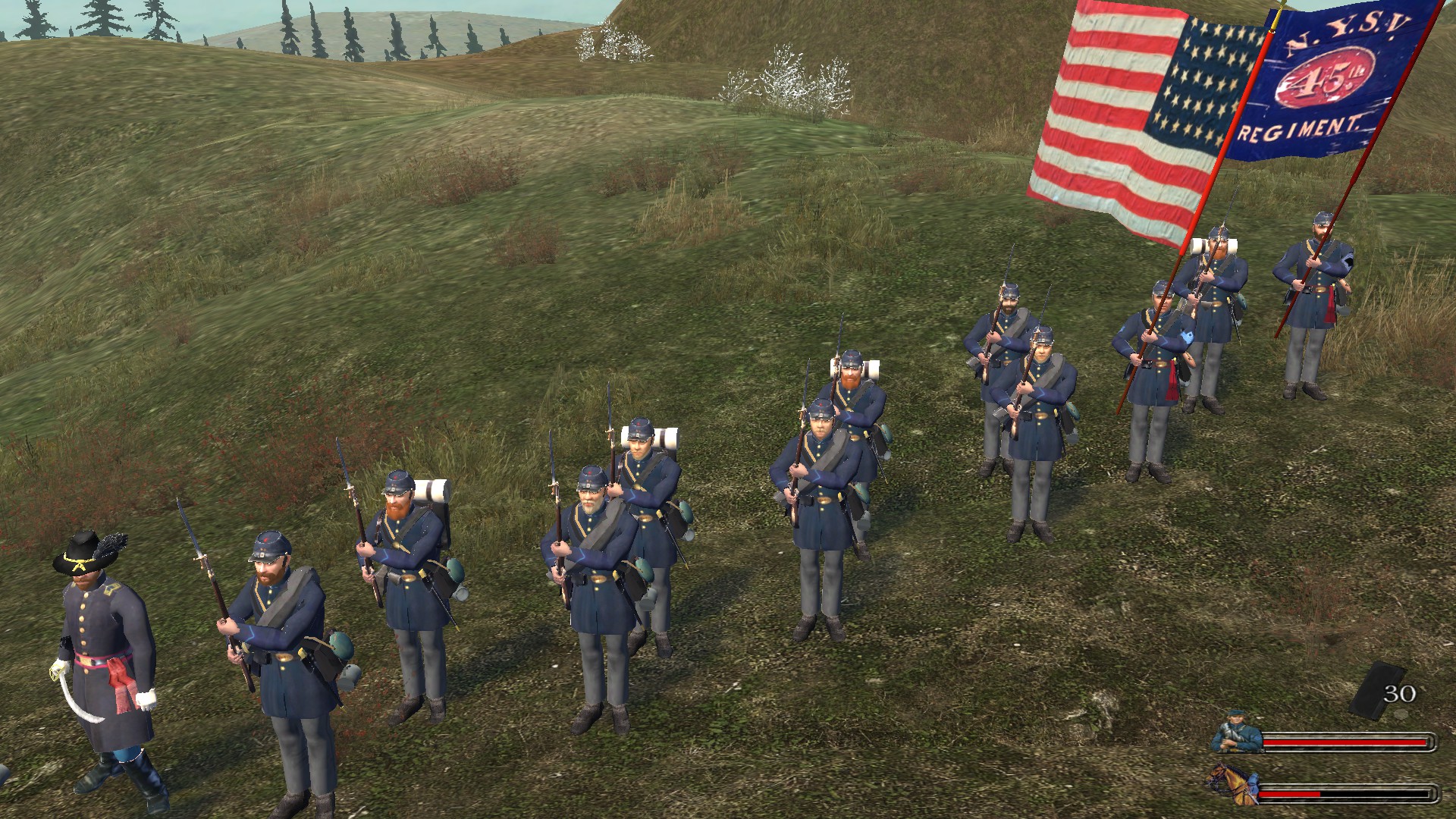

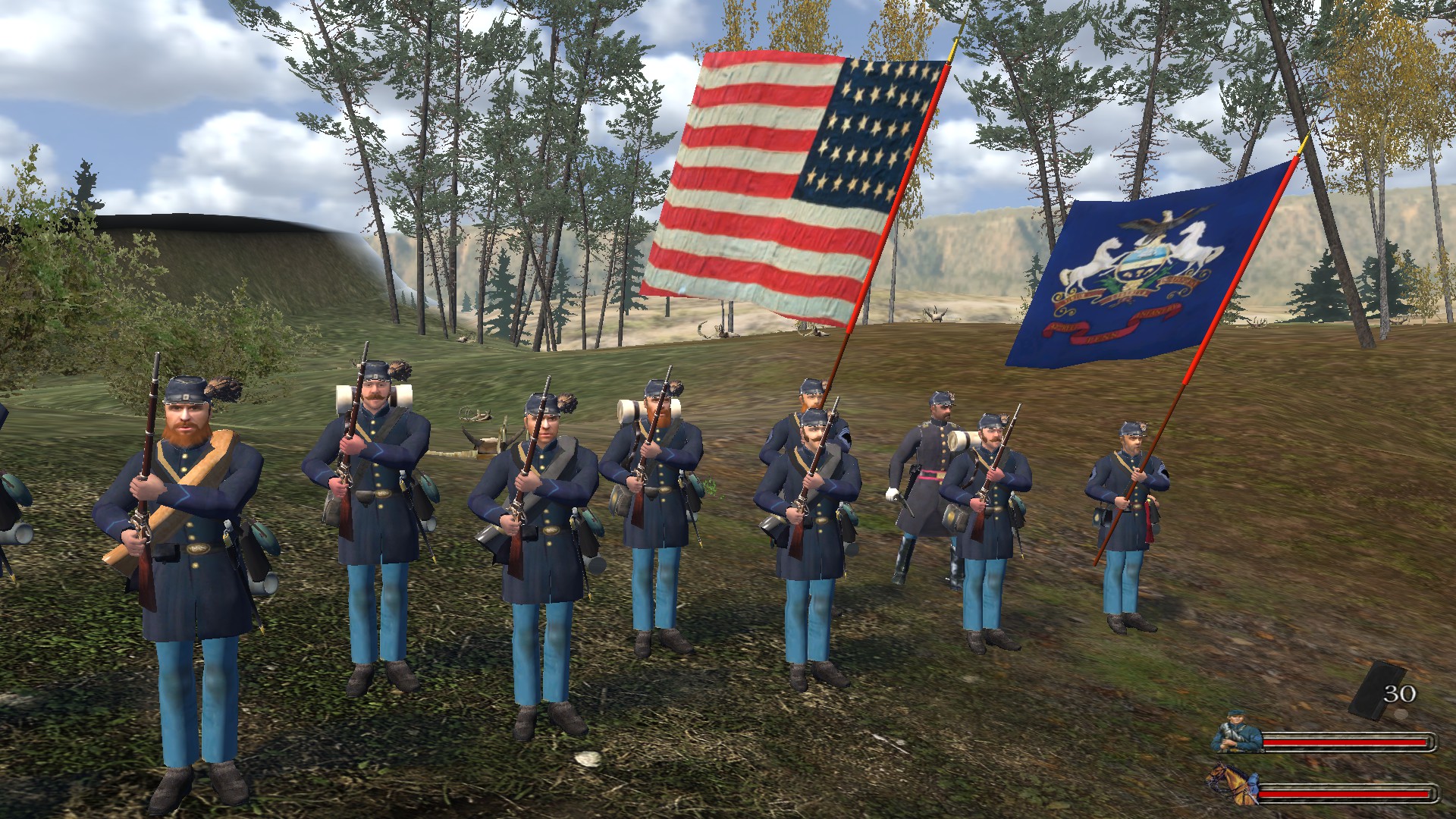
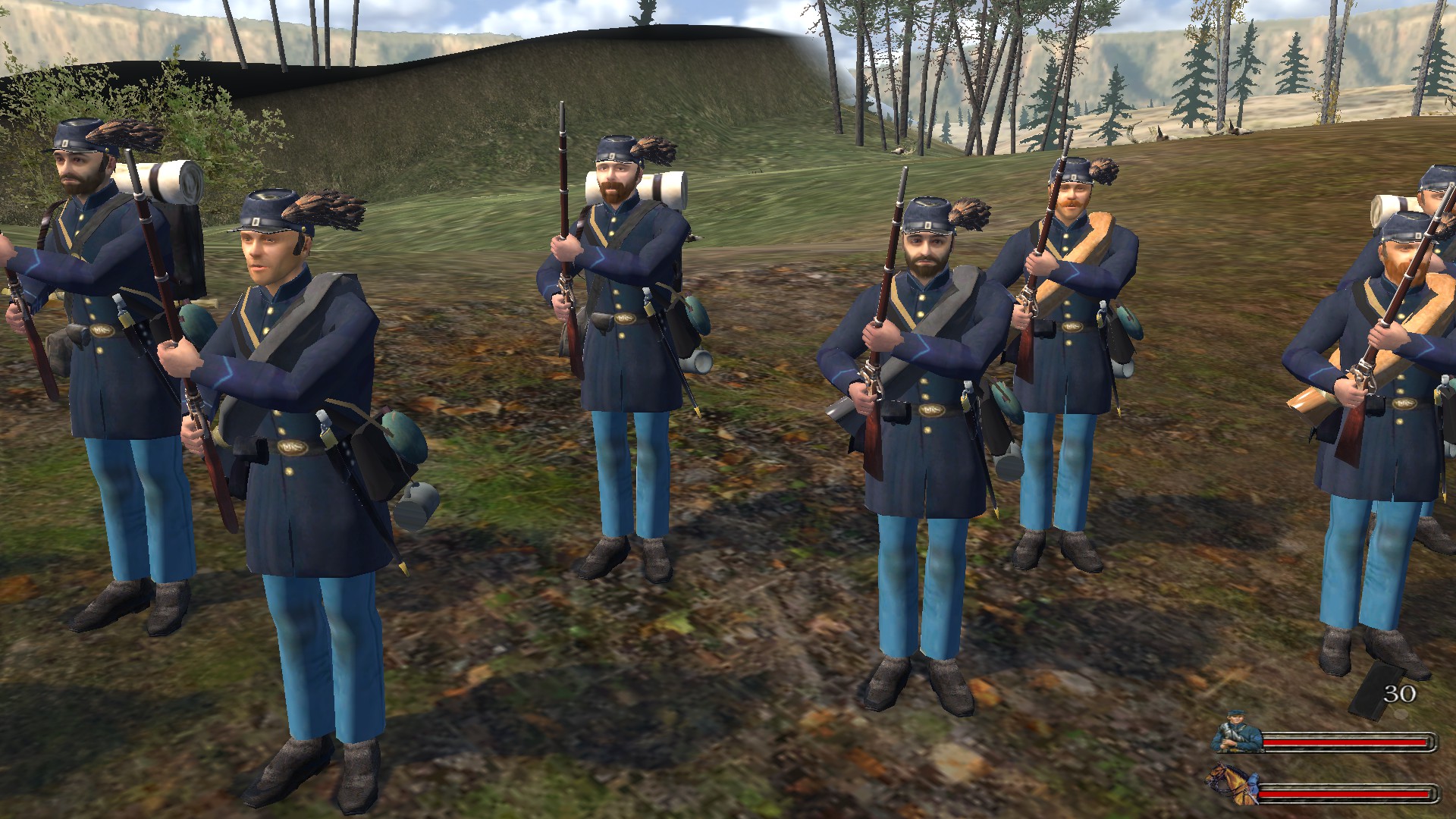
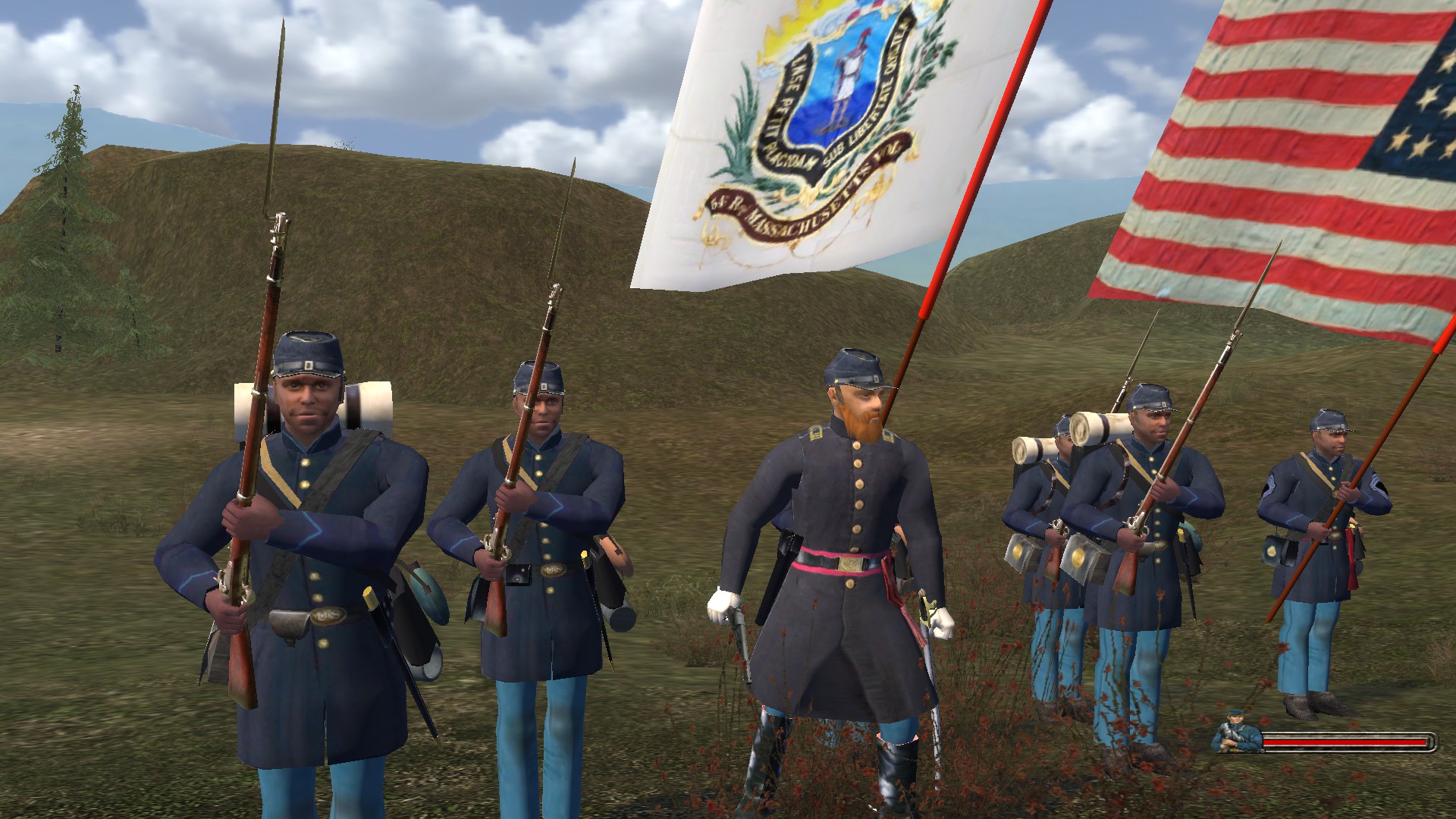
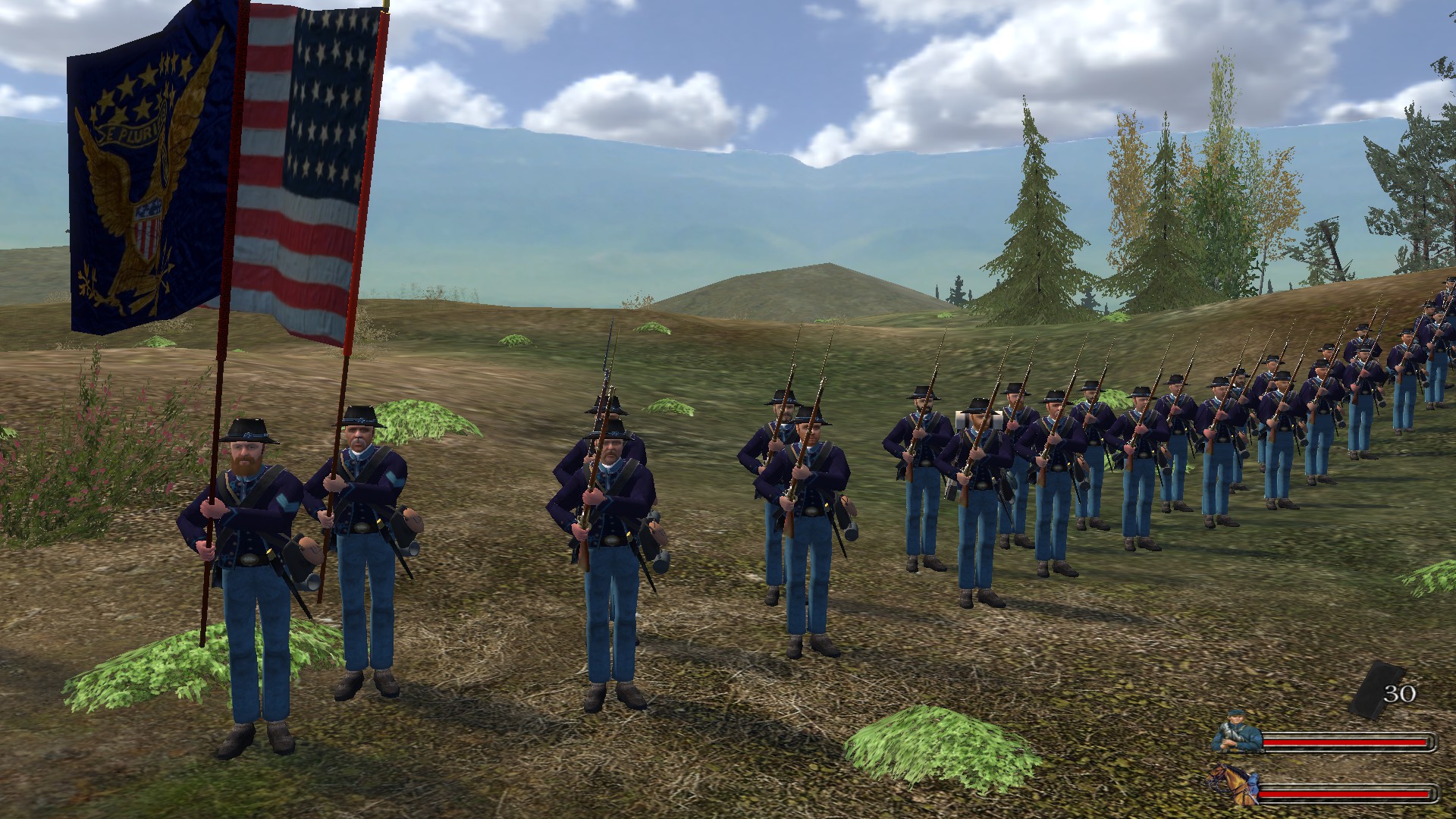
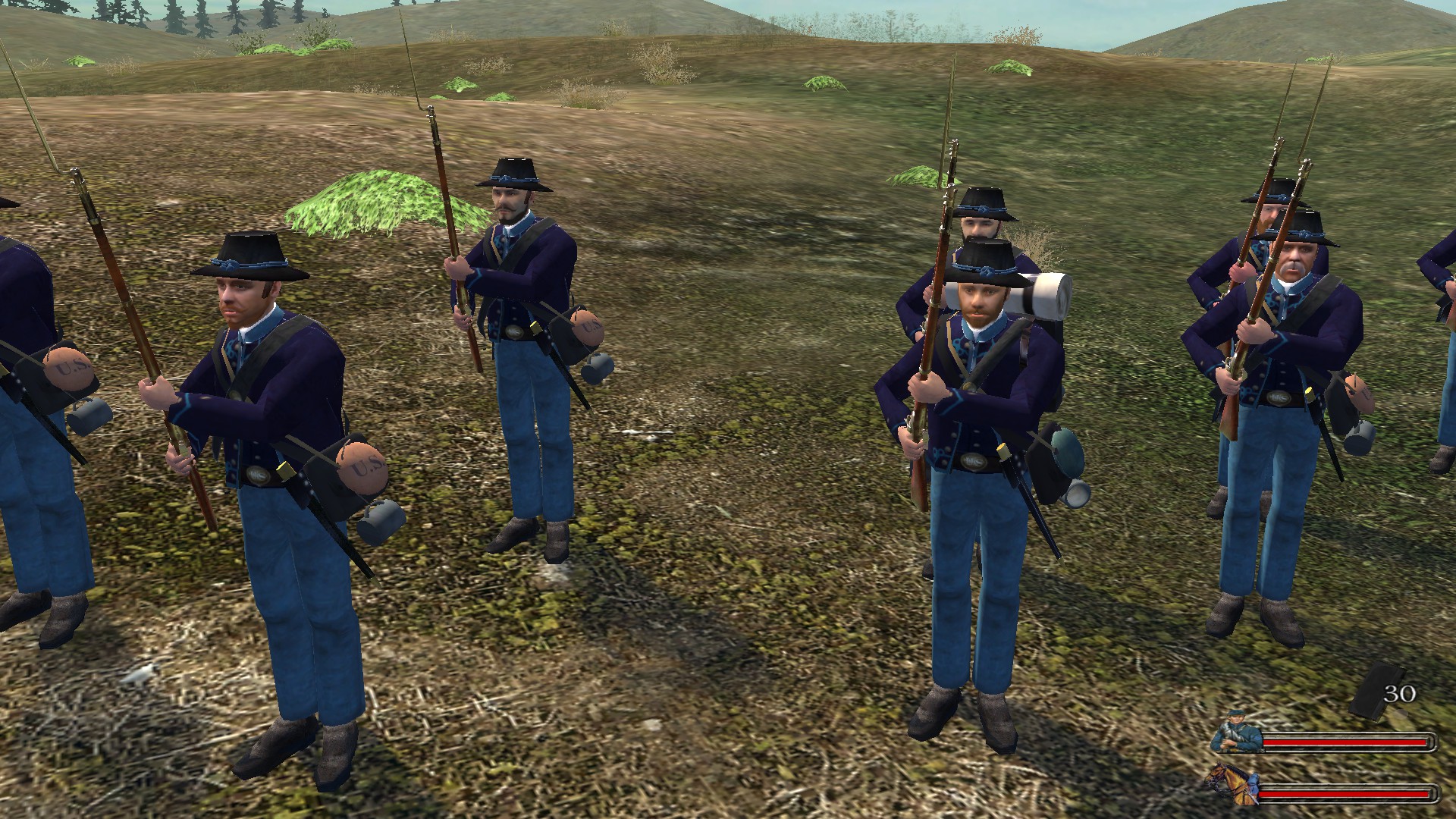
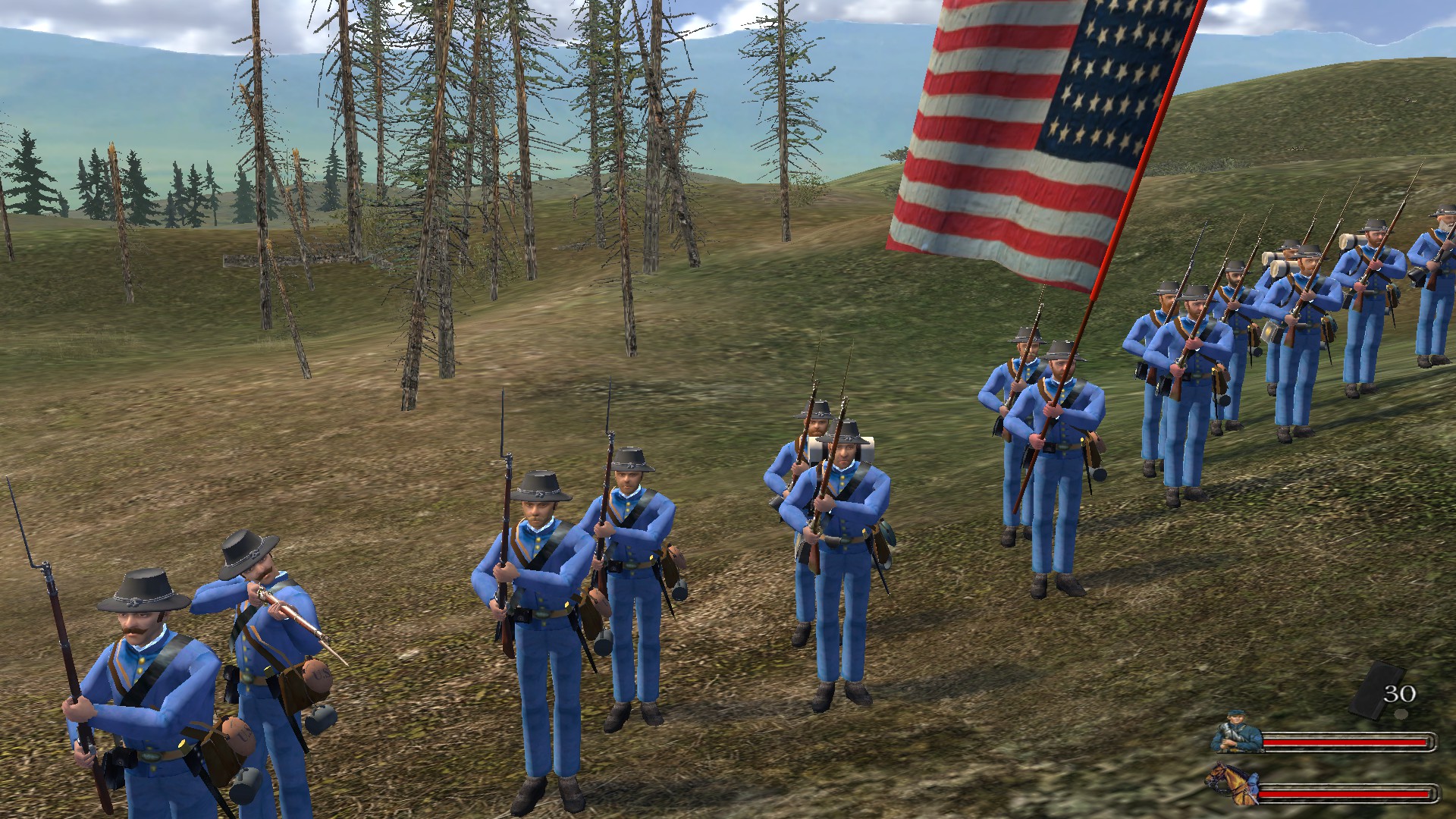
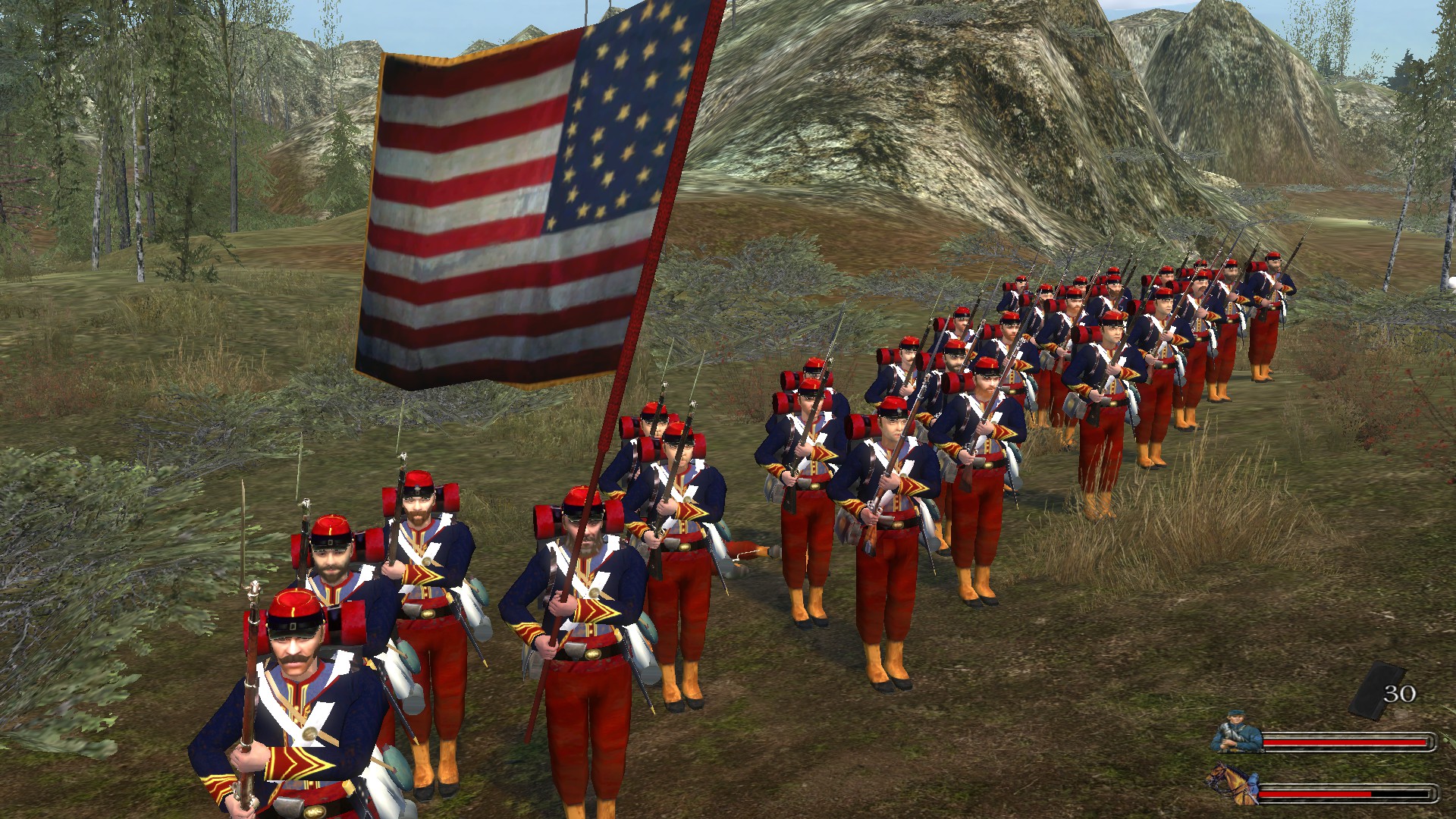
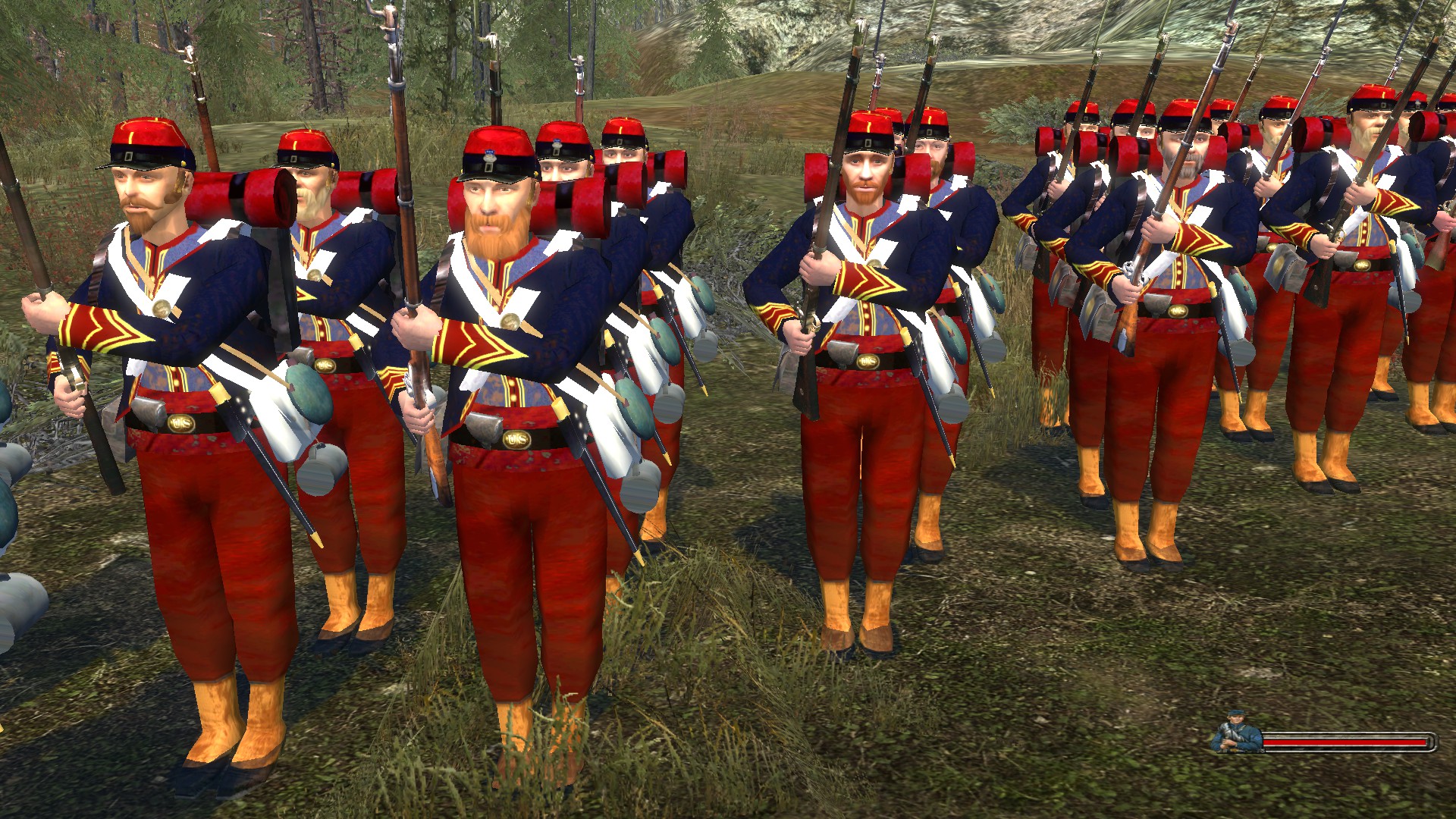
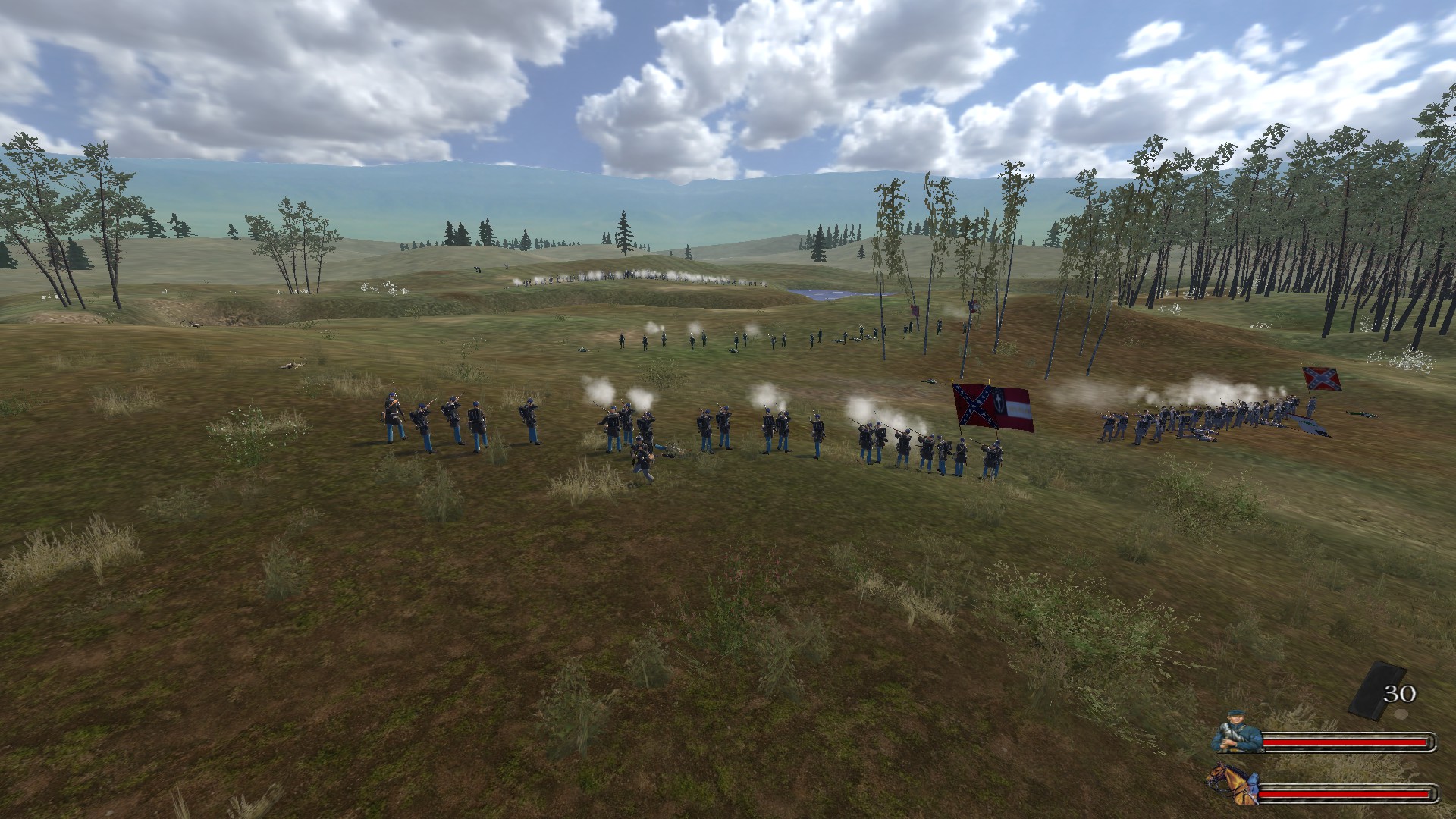


Looking good brother! Keep up the great work.
Thank you! More good stuff is on the way. :D
I guess I'm repeating myself at this point, but it's so great to see the effort that you're putting into this mod.
As always I appreciate the info on the regiments history.
Keep it up and thank you!
Thank you Rotz, always nice to read from you!
We are grateful your support and we are very happy to share our work with you and everyone. Glad you like the history too, we like to include it for good reading material, so we don't only share photos and information related to the mod itself. It also helps players understand the story of the soldiers they are seeing, and this can help with immersion also. Reading the stories, and then going into the game to see them and fight with them, it is certainly better than only looking at photos.
Keep an eye out, there is still more to see and it gets better. :)
Well, even if I'm not american at all, it's a really interesting topic. The collision of old tactics and new technologies, a rather young nation tearing itself apart...
Also it is rather well documented, so the digging for people interested in it isn't that hard.
But back to the immersion factor. It is awesome to know about the guys you're commanding on the field. These articles are great. But do you think it would be possible to add some of the infomation about the regiments ingame? I'm not really familiar with modding at all, so I don't know if this is in any way possible.
And have you ever heard of a man by the name Stand Watie?
Well, all I want to add is, that I'm hyped for the next update. I'm curious, what's added on the Confederate's side. ^^
Take care!
That's alright, you don't have to be an American to appreciate the history. I find the history of other nations fascinating myself. The Civil War in particular is very interesting though, certainly for the reasons you say, but also the personalities, the crazy stories and the coincidences that would happen, as well as the stories of incredible bravery, spirit and strength. The hardships those men experienced would make anyone today turn pale. They were made of stronger stuff back then haha.
As you say, it's a well documented period of history, but not many people take the time or are interested enough to actually go ahead and learn about it on their own. I hope with the mod, it can help make the history a bit more well known and appreciated, serving as a tool for people to learn as well as to have fun. What you say about adding the info into the mod itself, it's something I actually wished to do myself, funny that you mention it haha. It must be possible some way, would just have to figure out how. The game itself may not be able to teach you too much right now in terms of reading material, but it can serve as an inspiration for the player to become interested and want to find more information for themselves. And of course, when we can share some of the history with articles like this one, that's always a plus!
However the real learning with this mod comes on the battlefield. That is where players can see for themselves how different strategies and tactics work, and how to best use the assets at their disposal. Things that you may read about in history, for example a small force with breech loading or repeating weapons being able to hold off much larger forces using muzzle loaders, becomes something that can be experienced by the player. Many small things like this are there, and it is a unique way to learn because it is not so much spoken or written, but experienced.
All the new stuff will be revealed soon, we are very excited for the next preview and then the release. :D
Best regards!
So happy to see this I love the mod but I hope you can fix the issue of the Northern armies and Southern ones declaring war on each other really breaks the immersion. Other than that thank you for all your hard work you're amazing!!! Also my great great great grandpa was a bucktail so happy to see his brigade mentioned.
Hello, thank you for your compliments, it's truly appreciated very much. It makes us very happy to work on this project and see others having so much fun with it. We are honored that a descendant of one of the men we wish to represent sees what we are building and is happy with our work, that means a lot to us.
About the issue with the armies declaring war on each other, do you use the latest version of the mod? That issue should have been resolved already, the Confederate and Union armies should have very high relations among themselves. How long into the game did it first occur for you? Does it happen more than once?